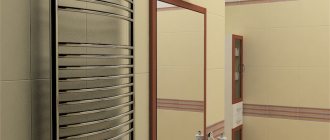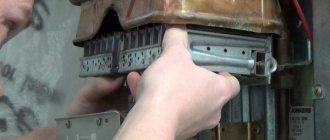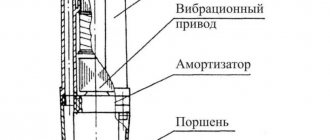An incorrectly functioning toilet is an annoying problem, the solution to which cannot be delayed.
The device is designed simply, and if the toilet does not flush well, the reasons and solutions can be determined by the owner and the situation can be corrected.
Tank device
To better understand the essence of the problem, you should familiarize yourself with the principle of operation of the drain tank. This is a container with a small hole in the bottom to drain water into the toilet. Through another hole, located on the side or also at the bottom, the tank is filled.
Internal mechanisms are called fittings, there are two of them:
- float valve for filling . The float is mounted on a lever connected to the valve membrane. Rising with the water level, the float at a certain moment closes the tap. The latter is most often located on the side, in expensive models - at the bottom. In the second case, the collection of water is not accompanied by noise;
- drain mechanism . It consists of a rubber bulb or petal that covers the drain hole and a rod system. By pressing a button or pulling the handle, the user removes the bulb from the saddle and opens the way for water. There are mechanisms with a more complex device: there is a second button to empty the tank halfway, or the ability to stop the drainage of water at any time by pressing the button again (aquastop).
The drain mechanism control is located on the lid or on the side.
The filling tap and drain mechanism are often separated, but there are models with a combined design (they are more expensive).
Let's sum it up
As you can see, there are not many reasons why water may leak in the toilet. Therefore, in principle, even an untrained person can cope with the problem.
It is only important to carefully read the instructions and act consistently and carefully. Then everything will work out - the toilet will work without failures. Is your toilet tank leaking? Well, let it flow - it’s not the biggest problem
After all, the flowing water will still flow into the sewer. And many homeowners think so. Until you receive a bill for your water consumption
Is your toilet tank leaking? Well, let it flow - this is not the biggest problem. After all, the flowing water will still flow into the sewer. And many homeowners think so. Until they receive a bill for the water consumed.
After this, they come to a belated understanding of the danger of the situation when your own money flows from the tank into the sewer, almost before your eyes. Therefore, a leak in the toilet flush tank must be repaired immediately, immediately after discovering this defect in the operation of your plumbing equipment. And in this article we will tell you how this is done.
How to fix a leaking toilet cistern if you are not familiar with its design? Of course not. Therefore, before reviewing the repair technology, we will dive into the structure of the object being restored.
A typical tank consists of the following elements:
- Float valve (faucet)
- a fitting connected to the water supply system, on which a shut-off unit controlled by a float is attached. If there is no water in the tank, the float pulls the valve shut-off element down, opening the fitting. When the tank is filled, the float rises up, closing the fitting. - Overflow
- a hollow column connected to the toilet. This column protects the tank from overflowing. When the water level reaches the edge of the column, the liquid will overflow into the toilet rather than rush into the toilet room. - Drain valve
- a hatch mounted on a hinge that closes the drain hole leading to the toilet. If the hatch is closed, water from the float valve fills the tank. If the hatch is open, then all the liquid accumulated in the tank flows down the drain hole into the toilet.
drain lever
– drain valve control mechanism. This unit consists of a rack with a rocker arm, the edge of which is connected to the valve (hatch) with a polymer or metal chain. By pressing on the free edge of the rocker, you pull the chain up and open the valve hatch. By releasing the lever (yoke), you loosen the chain and lower the hatch into place.
Of all the components described above, only the first three elements can provoke a leak in the toilet - tap, overflow, valve. Therefore, repairing a toilet cistern leak involves restoring the functionality of these particular components.
.
As you can see: there is nothing complicated in the design of the drain system. But enough theory, it’s time to move on to repairs.
Where to start the renovation?
Of course, starting with finding the cause of the water leak. After all, only by understanding why the toilet tank is leaking will you be able to eliminate the defect and establish normal operation of the drainage structure.
And there may be several reasons for this, but most often plumbers deal with the following options:
The first option is a leak through the overflow
– Diagnosed very simply – water is constantly flowing in the toilet cistern. It’s as if we have a bottomless structure in front of us, and not a container of 10-12 liters (or even less). Therefore, if you hear the murmur, get ready to change or repair the parts of the float valve.
The second option is a defective sealing gasket.
– noticeable by a constant stream that forms a characteristic limescale “drip” on the inner surface of the toilet bowl. If you see it, get ready to dismantle the tank and change the gasket.
The third option is a weakened drain valve.
– diagnosed by an intermittent stream flowing from the drain nozzles into the toilet bowl as water enters the tank. Therefore, if, while filling the container, water flows from the tank into the toilet, without any options, get ready to change the valve shut-off element.
As you can see: there are not so many prerequisites for the formation of a leak. However, each of them requires its own approach to repair. Therefore, next we will consider three technologies for eliminating leaks, linked to three reasons for its formation.
Why does the toilet start to flush poorly?
Having understood the structure of the device, it is easy to formulate the entire list of reasons for poor flushing:
- the drain hole in the tank is clogged;
- not enough water is collected;
- the annular channel under the rim of the bowl is clogged with deposits (in models with a shower-like circular flush);
- the surface of the bowl has become rough due to natural wear or damage;
- problems with the sewer pipe: incorrect slope, blockage, etc.
What's happened
Any most reliable household equipment becomes unusable over time.
This also applies to the toilet, which in this case begins to not flush well. We have to deal with this problem in more detail, find out the circumstances of its origin, and find methods for solving this problem. We will carry out all work ourselves without the involvement of expert plumbers. The following scenario is seen much more often - the toilet worked well and no troubles were noticed in its functioning. But suddenly the flushing started to get worse and worse. We invite you to familiarize yourself below with the most common problems that may arise during the operation of the device. We will consider not only the circumstances, but also methods for solving them on the spot using objects that everyone has in their home.
The most efficient drainage systems
Those who are just about to purchase a toilet should think about choosing the type of flush. The most powerful pressure is provided by designs with a high tank, that is, located almost under the ceiling. But due to their unpresentable appearance and loud noise, they are not used in apartments today - only in public toilets.
The currently popular “Compacts” use two types of drainage:
Water from the tank first rushes into the surrounding channel under the rim, then from there it pours into the bowl, so that the whole of it is washed evenly. Such a system is positioned as more effective, but this is a controversial issue. On the one hand, splashes are removed from the entire surface of the bowl and it actually becomes cleaner. But on the other hand, the flow intensity on the rear wall, which is most susceptible to contamination, decreases. The shower drain has one more drawback: if the water quality is low, the channel under the rim quickly becomes clogged with sediment;
soul-shaped (circular).- cascade _ All the water is discharged along the back wall, so that the side and front walls are almost not washed.
Much depends on the shape of the bowl. In visor and funnel-shaped ones, impurities are washed off well, in dish-shaped ones - not always. Therefore, the latter have lost popularity and are found today mainly only in hospitals.
Method 2 of 4 Assess the color of the stool
Look closely at it, sniff it, study the contents - and draw useful conclusions. So I work in your provincial town as a sewer man... But I came to tell you that yesterday I began to notice that you no longer need my help... Each column contains two numbers: the number of views and the number of visitors.
The article states that it’s normal to be a “sinker.” In my experience, it’s the other way around: if I switch to an unhealthy diet, I become a “sinker,” but usually I become a “floater.” Vegetarians would you consider the "ideal" stool (that is, one uncontaminated by the consumption of animal parts) to be a Floater. Many vegetarians have spent their entire lives searching to produce perfection - when in fact no special diet can reliably produce Floats.
Plumbing cleaning
After turning off the water supply, empty the tank and remove the lid from it.
Lifting the rubber bulb or petal, inspect the drain hole. Sometimes a small part gets into it: a gasket, hardware, a hose put on the nozzle of a filling valve to reduce noise, etc. This is especially likely if the tank is used without a lid.
If the source of the problem is not found during an external inspection, the tank is removed. To do this, unscrew two bolts passing through its bottom and the toilet shelf.
If the hardware does not feed, they are treated with WD-40 aerosol (the best option), kerosene, brake fluid or vinegar. Removing the tank allows you to inspect the drain hole more thoroughly.
Before putting the tank in place, it is strongly recommended to replace the gasket between it and the toilet: if torn out of place, it is unlikely to provide a tight seal for a long time, unless it is a completely new part.
The second option is to use soda
The second cleaning option is to use baking soda. Washing soda ash is better suited for punching the gap, but baking soda is also possible. Some experienced housewives recommend adding regular salt - about half the amount of soda.
Washing soda ash is suitable for cleaning toilets and sewer pipes.
- Take a pack of soda (500 grams) and pour it into the toilet.
- Then the toilet is filled with a liter of boiling water. After this, a reaction will begin inside the knee, which can also clear it of the blockage. Soda is an active alkali that can dissolve many substances, so it is often used not only for cleaning plumbing fixtures, but also kitchen accessories.
The toilet cistern drain is clogged
It happens that the clearance of the drain hole decreases due to lime deposits.
Pour 1 liter of water into the tank and resort to dry cleaning using one of the following methods:
- pour 100 g of orthophosphoric acid solution with a concentration of 5%-7%. After a quarter of an hour, wash off with water;
- add borax and vinegar in an amount of 0.5 liters. Wash off after 2 hours;
- dissolve 3-4 sachets of citric acid, wash off after a few hours (can be left overnight).
To remove deposits from the drain hole and from the mechanism parts, it is necessary to repeat chemical cleaning several times in a row. Ultra-effective compounds containing hydrochloric or oxalic acid are not used: they corrode rubber and plastic.
When performing chemical treatment, follow safety precautions: wear rubber gloves and try not to inhale acid fumes.
Preventative measures to combat blockages:
- use of special tablets for water softening: dropped in a container into the tank. The product gradually dissolves, so periodically it is necessary to add a new portion;
- installing a coarse filter (so-called mud filter or oblique filter) on the water supply to the tank.
What kind of blockages can there be and how to determine their cause
All sewer blockages are divided into several types:
- adhesion of fat to the internal surfaces of the pipe and adhesion of other waste. Such a blockage is usually called operational;
- the mechanical appearance differs from the previous one in that the cause of clogging is the entry of a foreign object into the system;
- as a result of the appearance of a fatty layer, a siphon blockage may occur;
- There is also a man-made problem, the cause of which is an error during installation of the system.
If the main access riser on the lower floor becomes clogged, then all the contents in the pipe rise up and come out in someone’s toilet, bathroom or kitchen. In such situations, you need to urgently call a specialist, since it is unlikely that you will be able to fix the problem yourself.
Finding an air lock in a sewer pipe
Ways to solve the problem
You can use regular soda to clean drains. To dilute the correct solution, you need to prepare several liters of boiling water in which a pack of soda will dissolve. The prepared liquid should be poured into the drain hole, and it is recommended to gradually add vinegar. In this way, a reaction can be achieved that will promote the rapid decomposition of fat
Most often, this method is used if there are no special means at hand, which include Mole, Tiret, etc. You can use chemicals yourself, but it is important to follow basic safety rules. Immediately before cleaning the sink, toilet or bathtub, you need to familiarize yourself with the operating instructions for a particular product. It is better to use this cleaning method when the pipe is not yet completely clogged, this way you can achieve greater efficiency
When the drain is completely clogged, it is dangerous to use chemicals because they can back up into the bathtub or sink. A proven and reliable method of cleaning is to use a simple plunger. When actions using soda or chemicals do not bring much effect, then this method can be used. In such cases, it is important that the bowl of the plunger completely covers the drain hole.
It is better to use this cleaning method when the pipe is not yet completely clogged, this way you can achieve greater efficiency. When the drain is completely clogged, it is dangerous to use chemicals because they can back up into the bathtub or sink. A proven and reliable method of cleaning is to use a simple plunger. When actions using soda or chemicals do not bring much effect, then this method can be used
In such cases, it is important that the bowl of the plunger completely covers the drain hole.
How to fix the problem using a plunger?
Actions are performed in a certain sequence:
- a sample filter is removed from the hole;
- the top hole of the bathroom must be tightly closed to achieve greater efficiency during the work process;
- The plunger must be installed so that no air lock appears, while the handle is placed vertically;
- without lifting the device from the bottom of the bathtub, you need to move the device up and down;
- on the last movement, the plunger rises from the water to check the effectiveness of its drainage. If necessary, the procedure is repeated several more times.
Another proven device is a metal cable, which is often used by plumbers. At one end of such an object there are fluffy wires, on the other side of the cable there is a handle for convenient use. The first end is inserted into the pipe, and rotational movements must be made using the handle. Depending on the degree of pipe clogging and the location of the problem, cleaning can take a relatively long time. If the problem is solved quickly, then the length of the cable is sufficient to effectively penetrate the sewer.
Water does not flow into the tank
Modern float valves do not close gradually as the float rises, as was the case before, but abruptly when the tank is filled to the required level. That is, water should flow with good pressure as long as the float is below the maximum mark.
If a thin stream oozes or no water flows at all, consider the following reasons:
- The float valve is clogged, as a result of which water is drawn in very slowly. The tap is cleaned with a thin wire, from time to time supplying water for a second to wash away the destroyed plaque. Act carefully so as not to damage the membrane;
- The water supply line is clogged. This happens with steel water pipes - plastic deposits do not become overgrown. The ideal solution is to replace the pipes.
If the last method is not feasible for any reason, resort to cleaning:
- shut off the water supply;
- the end of the string for hanging curtains is bent into the form of a hook several millimeters in size;
- the second end is bent like the handle of a brace;
- one person rotates the string by the “handle”, the second one feeds it into the pipe, having previously removed the valve (the ball valve can simply be moved to the “open” position).
Having passed the area to the closed valve, place a container under the inlet and open the water with low pressure. In this case, the string is slowly removed from the pipe, continuing to rotate.
Methods for eliminating air locks
Removing plugs using an installed air vent
Before removing the air lock in the heating, you need to find out its properties. The main one is density, which will always be lower than the same indicator of water. Accordingly, the liquid will displace air upward and in the direction of circulation.
Therefore, to remove air, it is necessary to ensure the release of steam. To do this, you should install special devices - air vents and Mayevsky taps. They work on the principle of a check valve. When a certain pressure is exceeded, steam acts on the valve seat. The rod moves, releasing air from the radiator or pipe. After the pressure normalizes under the action of the spring, the rod takes its old position.
An air lock in a cast iron or aluminum radiator can damage the housing. Therefore, when such a situation arises, you need to solve the problem immediately.
The tank is leaking
Also, water may not be collected due to the fact that it flows into the drain hole without permission.
There may be three reasons:
- The rubber from which the valve that closes the hole is made (pear or petal) has lost its elasticity due to natural aging. The part is replaced with a new one;
- the valve does not fit tightly to the seat due to deposits. Methods for removing deposits are described above;
- The drain mechanism rods are jammed or it is damaged. In the first case, the rods are adjusted, in the second, the mechanism is changed.
Preventing poor flushing
The toilet often becomes a place where foreign objects accumulate. Therefore, it is important to monitor its condition all the time so that drainage problems do not occur again. To do this, it is important to remove foreign objects from the toilet at all times.
Regularly chemically clean the tank and the bowl itself. For this purpose, household chemicals are used. You can clean the sewer mechanically using a plumbing cable.
Regularly open the tank lid and check whether the fittings are working correctly. Breakdowns in this part of the device are easier to prevent than to fix.
Damage to enamel
Ceramic toilets, which are the most common, are coated with a smooth glaze or enamel. Over time, the coating wears out, and when struck by carelessness, scratches, chips and cracks remain on it. As a result, the smooth surface turns into a rough one and begins to resist the flushing of sewage.
to the enamel is a sure sign that it is time to purchase a new toilet, but if it is not possible to do this yet, they resort to temporary restoration:
- After rinsing and drying the toilet, rough areas are treated with fine-grained sandpaper;
- thoroughly wash the toilet so that no dust remains, then dry and degrease;
- waterproof sealant or ceramic putty is applied to problem areas;
- after waiting for the mixture to dry completely, paint the treated areas with powder paint using a paint gun;
- wait for the paint to dry completely (about 3 days are required) and resume operation of the device.
The improvised glaze does not last long, so it is recommended to plan to purchase a new toilet in the near future.
Recommendations
Oddly enough, it’s worth thinking about poor flushing when choosing a toilet and during the first time you use it. Sometimes an ill-considered purchase causes problems months or years later. Let's consider the main recommendations in this regard.
It is worth paying attention to the location of the tank. The top one always washes off better than the bottom one.
It provides more powerful water pressure. If possible, it is worth installing the tank higher.
Toilets with circular flush are good and popular, but during operation, troubles happen to them. It just so happens that it is the back wall that gets dirty the most. The circular flush washes the entire bowl completely and does not cause splashes. However, for the most contaminated area there is not enough water, and its pressure is rather weak. Therefore, in some cases the flush may be poor.
The visor inside the bowl is a good indicator. Thanks to it, flushing efficiency increases. But often this design becomes a source of unpleasant odor. Waste remains on the visor for too long, which leads to inconvenience. But the flush is really better than its analogues.
The material of the bowl also matters. Porcelain plumbing is considered the best: the surface is smooth, has almost no pores, and nothing interferes with the flow of water. Faience covered with glaze is also quite good in practice. It is only slightly inferior to porcelain. But ceramics can bring a lot of problems. The enamel on it easily deteriorates, and chips interfere with water circulation.
Any tank should be properly monitored. The nozzle and other areas prone to fouling should be cleaned regularly.
Water is retained in the bowl
If the tank works perfectly, but water fills into the toilet and slowly leaves, the problem is a clogged sewer.
There are three ways to clean drains:
- using a plunger through the drain hole of a nearby sink or bathtub. If the blockage is weak, the pressure applied by the plunger will move it out of place;
- plumbing cable. They act in the same way as with a string when cleaning a water pipe: they rotate the cable while simultaneously feeding it into the sewer;
- chemical means. Modern compositions based on acids and alkalis effectively corrode even the most resistant corks. One of the most popular is “Mole”. These products are caustic, so you must follow safety precautions and act strictly according to the instructions.
In private homes, the causes of frequent sewer blockages may be:
- use of small diameter pipes. The minimum diameter of pipes after the toilet is 100 mm;
- incorrect pipe slope. The source of problems is either insufficient slope or excessive slope. In the second case, the water runs off too quickly, not having time to carry the solid fractions with it, and they remain in the pipe. The amount of slope depends on the diameter of the pipe. For products DN100 it is 0.02 (2 cm per meter). The minimum permissible slope for such pipes is 0.012 (1.2 cm per meter);
- a significant distance from the toilet to the riser. According to the standards, it cannot exceed 1 m;
- lack of a vent pipe. This is the top of the riser, brought out through the roof. Provides communication between the internal space of the sewer system and the atmosphere, so that when a large amount of water moves in the pipes, a vacuum is not created. If an air valve is installed instead of a drain pipe, gas pressure may back up the drains from the toilet, causing them to move more slowly.
Air valves can be installed if there is at least one drain pipe in the system.
Frequently asked questions
Since the design of all toilets is almost the same (the differences are unimportant and in our case may not be taken into account), some points can be addressed immediately, before unsolvable issues arise during the troubleshooting process.
Most problems arise due to the same reasons, so advice is always very useful.
What is better, trying to fix the problem or replacing the toilet right away?
The choice depends on the age and condition of the plumbing. If the toilet is old and uncomfortable, it is better to replace it. At the same time, it is necessary to take into account the specifics of the problems - sometimes replacing the device does not solve the problem.
Does it make sense to replace both the toilet and the tank at once?
We need to find out which node is the source of the problem. If the condition and performance of the second node are quite satisfactory, it is not necessary to change them.
What should be done if the toilet flushes, but ineffectively - you often have to repeat the procedure 2-3 times?
The easiest way is to increase the volume of drained water. You can adjust the reservoir (newer models have several options for adjusting the valve). If the problem cannot be solved, you need to purchase a larger capacity tank.
What is the best way to unclog a clogged toilet?
It has already been said that it is more correct to act mechanically - to use a cable. The most effective method is hydrodynamic cleaning, which can be done using a Karcher car wash or similar.
If it is not possible to change the system configuration, how else can you eliminate the air lock?
Sometimes the problem is successfully solved with the help of an air valve, which is installed on a horizontal section of the sewer pipe. It balances the pressure in different parts of the system, allowing the air lock to be released freely. However, some models of such valves release foul-smelling sewer gases into the room, which is unacceptable in apartments.
It is important to keep in mind that eliminating one problem does not always give the expected result. Often problems occur in pairs or in larger numbers. Therefore, if the result turns out to be unsatisfactory, you should not despair, but look for additional causes of the problems. In any case, eliminating the causes automatically solves the problem, you just need to take all the necessary measures.
Siphon membrane repair
If water drains from the tank only after repeated pressing or the liquid constantly leaks, the membrane should be replaced.
Installation of a flush cistern with a side drain: 1 – overflow pipe; 2 - water supply; 3 - float valve; 4 — float; 5— float lever, 6— siphon; 7— membrane; 8 - metal plate with holes; 9 - traction; 10 — water release lever; 11 - gasket; 12 – siphon retaining nut; 13 — fixing nut; 14 - drain pipe.
This work is carried out as follows:
1. Instead of the tank lid, place a crossbar; for this you can use a small rail or tube.
2. Tie the float lever (5) to the crossbar.
3. Completely drain the water from the cistern.
4. The nut that connects the drain pipe to the tank (13) should be removed.
5. Simply loosen the siphon nut (12) a little.
6. The siphon itself (6) must be disconnected and removed.
7. Remove the damaged membrane (7) and install a new one, which should have exactly the same dimensions and shape as the old one.
8. Install the cistern fittings in the reverse order.
Faulty tank drain button
If the flush button does not work, then in most cases it is necessary to repair the damaged rod (9), which connects the toilet button to the flush mechanism.
Wire traction
Button with pull rod in the form of a tube
It is necessary to disconnect the mechanism and the broken element, remove and install a new one. However, for temporary use, you can make the pull yourself using a thick piece of wire. But for normal and long-term operation, you should purchase a new, serviceable mechanism.











